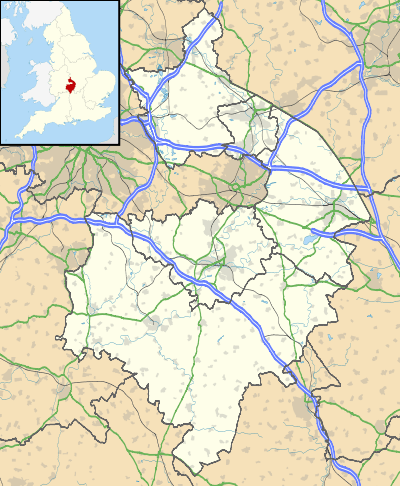Fillongley
Fillongley is a village and civil parish in the North Warwickshire district of Warwickshire in England. The village is centred on the crossroads of the B4102 (which connects Solihull and Nuneaton) and the B4098 (connecting Coventry and Tamworth). The population of the parish taken at the 2011 census was 1,484.[1] It is situated 5.5 (8.8 km) miles east of Bedworth (the closest town), 6.5 miles (10.5 km) southwest of Nuneaton and an equal distance northwest of Coventry.
| Fillongley | |
|---|---|
The B4098 road | |
 Fillongley Location within Warwickshire | |
| Population | 1,484 (2011) |
| OS grid reference | SP279872 |
| District | |
| Shire county | |
| Region | |
| Country | England |
| Sovereign state | United Kingdom |
| Post town | Coventry |
| Postcode district | CV7 |
| Website | Fillongley Community Website |
History
In medieval times there were two castles. These might not have existed at the same time and neither survived into the 16th century. The earliest was a ring earthwork of King Stephen's time. The second was probably a fortified manor house, held by the de Hastings family. Henry de Hastings (c.1235–c.1268) was Constable of Kenilworth Castle in 1265-1266 for Simon de Montford during the latter's conflict with King Henry III. In February 1300/1 his son John Hastings, 1st Baron Hastings (1262-1313), Lord of Abergavenny, had licence to crenellate his "manor and town of Fillongley in Warwickshire".[2] He was buried at the Greyfriars, Coventry, Warwickshire. The manor house was still standing during the reign of Edward III (1327-1377) but was unoccupied by the de Hastings. It later passed to the Beauchamp Earls of Warwick.
Church
The parish church of St Mary and All Saints dates from the 12th century but the tower was a later addition. Inside are examples of 14th-century stained glass. Among the graves is that of Isaac Pearson, the uncle of the Victorian novelist George Eliot, who lived in Arbury nearby.
References
- "Civil Parish population 2011". Retrieved 28 December 2015.
- GEC Complete Peerage, vol.VI, p347